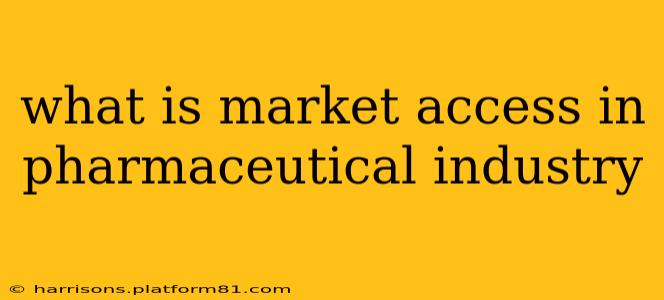Market access in the pharmaceutical industry refers to the complex process of ensuring that patients can obtain and afford the medications they need. It's far more than simply getting a drug approved by regulatory bodies like the FDA; it's about navigating a multifaceted landscape of hurdles to ensure patients have timely access to life-saving and life-improving therapies. This includes negotiating pricing, securing reimbursement from healthcare payers (like insurance companies and government programs), and educating healthcare professionals about the benefits and appropriate use of the drug. In essence, it's the bridge between drug development and patient care.
What are the Key Challenges in Achieving Market Access?
The pharmaceutical industry faces numerous obstacles in gaining market access for new drugs. These challenges often interrelate and create a complex web of difficulties:
-
High Drug Prices: The cost of developing and manufacturing innovative medicines is substantial. This often leads to high list prices, creating a barrier to affordability for many patients and putting pressure on healthcare systems. Negotiating favorable reimbursement rates with payers is crucial.
-
Reimbursement Policies and Procedures: Each country and even each payer within a country has its own complex reimbursement policies and procedures. These vary greatly in terms of requirements for evidence of efficacy and safety, as well as the criteria used to determine whether a drug will be covered and at what price.
-
Evidence Generation and Communication: Demonstrating the value of a new drug requires robust clinical trial data showing its efficacy, safety, and cost-effectiveness relative to existing treatments. Effectively communicating this evidence to healthcare professionals and payers is vital for securing reimbursement. This often involves real-world evidence studies conducted after initial market approval.
-
Competition: The pharmaceutical market is intensely competitive. Securing market access requires differentiating a new drug from existing therapies and highlighting its unique advantages.
-
Regulatory Hurdles: While regulatory approval is a prerequisite, navigating the post-approval regulatory landscape is also crucial. This includes managing ongoing safety surveillance and responding to changes in regulatory requirements.
How is Market Access Achieved?
Gaining market access involves a multi-pronged approach:
-
Strategic Pricing: Developing a pricing strategy that balances profitability with affordability and payer acceptance is crucial.
-
Health Technology Assessments (HTAs): HTAs are systematic evaluations of the clinical and economic value of healthcare technologies, including pharmaceuticals. Pharmaceutical companies often need to undertake HTAs to demonstrate the value of their products to payers.
-
Payer Negotiations: Direct negotiations with payers are essential to secure favorable reimbursement rates and ensure that the drug is included in formularies (lists of covered medications).
-
Market Access Teams: Many pharmaceutical companies employ dedicated market access teams with expertise in pricing, reimbursement, health economics, and policy.
-
Patient Advocacy: Engaging with patient advocacy groups can help ensure that the needs and perspectives of patients are considered in market access strategies. This is especially important for drugs targeting rare diseases or conditions with unmet medical needs.
What are the Roles of Different Stakeholders in Market Access?
Numerous stakeholders play crucial roles in the market access process:
-
Pharmaceutical Companies: Responsible for developing, pricing, and promoting their drugs, and for navigating the complexities of reimbursement negotiations.
-
Healthcare Payers (Insurance Companies, Government Programs): Make decisions about which drugs to cover and at what price, based on factors such as cost-effectiveness, efficacy, and safety.
-
Healthcare Professionals (Physicians, Pharmacists): Prescribe and dispense medications, influencing patient access through their prescribing habits and advice.
-
Regulatory Agencies (e.g., FDA, EMA): Approve new drugs based on rigorous safety and efficacy standards.
-
Patients and Patient Advocacy Groups: Play a critical role in advocating for access to life-saving and life-improving medications.
What is the Future of Market Access in the Pharmaceutical Industry?
The future of market access is likely to involve an increasing focus on:
-
Value-based pricing: Shifting from price-based reimbursement to value-based reimbursement, where payments are tied to the clinical and economic outcomes of a treatment.
-
Real-world evidence: Using real-world data to demonstrate the effectiveness and cost-effectiveness of drugs in routine clinical practice.
-
Data analytics and artificial intelligence: Leveraging data to better understand patient needs and predict market access challenges.
-
Digital health technologies: Utilizing digital tools to improve patient engagement and adherence to treatment, which can lead to better outcomes.
Understanding market access is crucial to ensuring that patients have access to the innovative medications they need. It's a dynamic and complex field requiring collaboration among all stakeholders to optimize the delivery of life-changing therapies.
